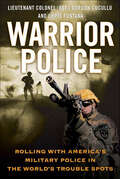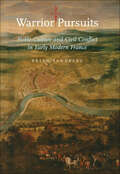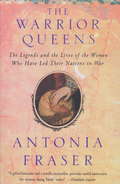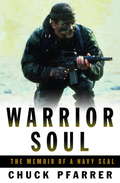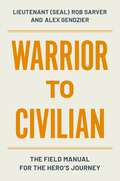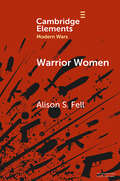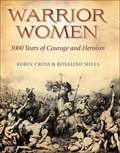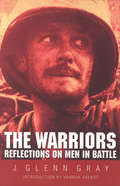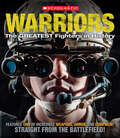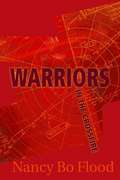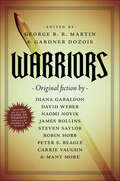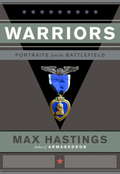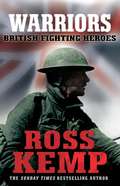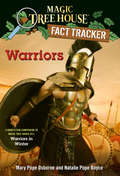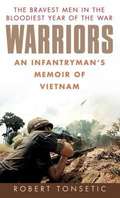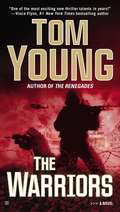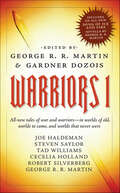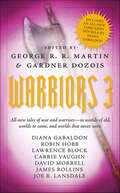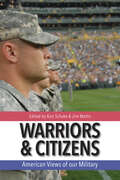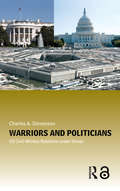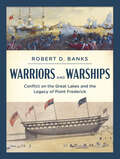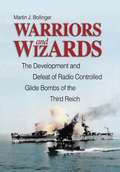- Table View
- List View
Warrior Police: Rolling with America's Military Police in the World's Trouble Spots
by Gordon Cucullu Chris FontanaFor the first time ever, author Gordon Cucullu gives readers an explosive inside look at modern military police units and their role in defending our freedom.America has been at war on several fronts since the 9/11 attack. While public attention has focused on Marines, conventional Army units, and Special Operations Forces, a lion's share of the war-fighting has been done, under media radar, by Military Police units. These squad and platoon-sized units patrol dangerous urban streets, build up local police units to improve neighborhood stability, and conduct civic action missions. On many occasions they have rushed into a vicious firefight to come to the assistance of infantry units in desperate straits. They keep villages Taliban-free, monitor balloting sites, and interdict drug shipments. In detention centers at Camp Bucha, Iraq, Bagram, Afghanistan, and Guantanamo, Cuba they guard some of the most dangerous terrorists in history.The story is told by the soldiers themselves, recounting what they have seen and experienced, along with historical context and first-hand field observations by the author team who were provided with unique inside access. Warrior Police takes readers into the bloody streets of Iraq, the dangerous back-country of Afghanistan, and wherever our Military Police are needed.
Warrior Pursuits: Noble Culture and Civil Conflict in Early Modern France (The Johns Hopkins University Studies in Historical and Political Science #128)
by Brian SandbergHow did warrior nobles’ practices of violence shape provincial society and the royal state in early seventeenth-century France?Warrior nobles frequently armed themselves for civil war in southern France during the troubled early seventeenth century. These bellicose nobles’ practices of violence shaped provincial society and the royal state in early modern France. The southern French provinces of Guyenne and Languedoc suffered almost continual religious strife and civil conflict between 1598 and 1635, providing an excellent case for investigating the dynamics of early modern civil violence. Warrior Pursuits constructs a cultural history of civil conflict, analyzing in detail how provincial nobles engaged in revolt and civil warfare during this period. Brian Sandberg’s extensive archival research on noble families in these provinces reveals that violence continued to be a way of life for many French nobles, challenging previous scholarship that depicts a progressive "civilizing" of noble culture. Sandberg argues that southern French nobles engaged in warrior pursuits—social and cultural practices of violence designed to raise personal military forces and to wage civil warfare in order to advance various political and religious goals. Close relationships between the profession of arms, the bonds of nobility, and the culture of revolt allowed nobles to regard their violent performances as "heroic gestures" and "beautiful warrior acts." Warrior nobles represented the key organizers of civil warfare in the early seventeenth century, orchestrating all aspects of the conduct of civil warfare—from recruitment to combat—according to their own understandings of their warrior pursuits.Building on the work of Arlette Jouanna and other historians of the nobility, Sandberg provides new perspectives on noble culture, state development, and civil warfare in early modern France. French historians and scholars of the Reformation and the European Wars of Religion will find Warrior Pursuits engaging and insightful.
Warrior Queens: The Legends and the Lives of the Women Who Have Led Their Nations in War
by Antonia FraserIn this panoramic work of history, Lady Antonia Fraser looks at women who led armies and empires: Cleopatra, Isabella of Spain, Jinga Mbandi, Margaret Thatcher, and Indira Gandhi, among others.
Warrior Soul
by Chuck Pfarrer"Since the first navy frogmen crawled onto the beaches of Normandy, no SEAL has ever surrendered," writes Chuck Pfarrer. "No SEAL has ever been captured, and not one teammate or body has ever been left in the field. This legacy of valor is unmatched in modern warfare."Warrior Soul is a book about the warrior spirit, and it takes the reader all over the world. Former Navy SEAL Chuck Pfarrer recounts some of his most dangerous assignments: On a clandestine reconnaissance mission on the Mosquito Coast, his recon team plays a deadly game of cat and mouse with a Nicaraguan patrol boat. Cut off on the streets of Beirut, the author's SEAL detachment must battle snipers on the Green Line. In the mid-Atlantic, Pfarrer's unit attempts to retrieve--or destroy--the booster section of a Trident ballistic missile before it can be recovered by a Russian spy trawler. On a runway in Sicily, his assault element surrounds an Egyptian airliner carrying the Achille Lauro hijackers.These are only a few of the riveting stories of combat patrol, reconnaissance missions, counter-terrorist operations, tragedies, and victories in Warrior Soul that illustrate the SEAL maxim "The person who will not be defeated cannot be defeated."From the Hardcover edition.
Warrior to Civilian: The Field Manual for the Hero's Journey
by Robert Sarver Alex GendzierA compassionate, practical guidebook for veterans transitioning from active duty to civilian life and for the loved ones supporting their journey. "Challenging yet reassuring....a key addition to every veteran&’s packing list ." --Stan McChrystal, General, US Army (Ret) and Co-Founder and CEO, McChrystal Group Some important statistics: There are over 22 million veterans alive today Each year, more than 200,000 new veterans transition out of active duty. Approximately 22 veterans commit suicide a day, and even more are living with PTSD, traumatic brain injury (TBI), struggling with substance abuse, homelessness, and experience many, many other difficulties. It's clear that we have not honored the promise we make to veterans: that we as a country will help them after they've served and sacrificed. And while there are many books written by and for veterans, only a small selection of those address the transition to civilian life, and none are a truly complete reference for stepping out of service and back into normal life. Warrior to Civilian covers a range of topics, from the practical—finding a job, reintegrating into family life—to the more challenging topics, like dealing with loss, and finding new purpose in life. This well-curated resource incorporates stories, insights, and observations from veterans and their partners; evidence-based advice from health professionals and experts who work closely with veterans; and inspiration taken from heavyweights like Jon Kabbat-Zinn and Tony Robbins. The authors take care to address the unique challenges faced by veterans of color, and those in the LGBTQ+ communities. With support from some of our country's most recognizable military members, authors Rob Sarver, a former SEAL, and Alex Gendzier, combine their voices and their experiences in and out of the military in a unique way that will make this resource shine. Scaffolded by the hero's journey, in which the hero experiences a series of transformative events, they reveal that within the loss that many veterans have suffered while serving and suffer in the transition, there is great opportunity for healing.
Warrior Women: The Cultural Politics of Armed Women, c.1850–1945 (Elements in Modern Wars)
by Alison S. FellThis Element examines women warriors as vehicles of mobilisation. It argues that women warrior figures from the mid-nineteenth century until the end of the Second World War are best understood as examples of 'palimpsestic memory', as the way they were represented reflected new contexts while retaining traces of legendary models such as Joan of Arc, and of 'travelling memory', as their stories crossed geographical borders and were re-told and re-imagined. It considers both the instrumentalisation of women warriors by state actors to mobilise populations in the world wars, and by non-state actors in resistance, anti-colonial and feminist movements. Fell's analysis of a broad range of global conflicts helps us to understand who these actors were, what motivated them, and what meanings armed women embodied for them, enabling a fresh understanding of the woman warrior as an archetype in modern warfare.
Warrior Women
by Rosalind Miles Robin CrossFrom earliest times, women gained access to leadership in times of conflict and proved themselves equal to the challenge of commanding during war. Women leaders abounded in the ancient world from Ireland to Israel, sometimes through the accident of birth, but often rising to power through naked opportunism and raw courage in the ranks--and it is no accident that women war leaders, like men, are often famous for their strong sexual drive. Wherever there is war, there has often been a woman at the helm. Later ages frequently wrote these women out of history, but their stories have refused to die. From the legendary leader of the Amazons who fought the greatest of Greek heroes, Achilles, to the Iron Ladies of today, the women of both West and East directing military campaigns and leading their countries in war. Presenting an array of fascinating and sometimes little known women war leaders, popular author Rosalind Miles and the acclaimed military historian Robin Cross do full justice to the achievements of these women, some of whose amazing stories have so far never been told.Warrior women include: Penthesilea the Amazons queen, Deborah, Cleopatra VII, Boudicca, Eleanor of Aquitaine, Joan of Arc, Elizabeth I, Grace O'Malley, Deborah Samson, Nadezda Durova, Harriet Tubman, Anna Etheridge, Soldaderas; Flora Sandes, Lily Litvak, Women of the Warsaw Ghetto, Hanna Reitsch, Ruth Werner, Jeanne Holm, Margaret Thatcher, Women in Today's Armies, Martha McSally and more. . .
The Warriors: Reflections on Men in Battle
by Hannah Arendt J. Glenn GrayJ. Glenn Gray entered the army as a private in May 1941, having been drafted on the same day he was informed of his doctorate in philosophy from Columbia University. He was discharged as a second lieutenant in October 1945, having been awarded a battlefield commission during fighting in France. Gray saw service in North Africa, Italy, France, and Germany in a counter-espionage unit. Fourteen years after his discharge, Gray began to reread his war journals and letters in an attempt to find some meaning in his wartime experiences. The result is The Warriors, a philosophical meditation on what warfare does to us and an examination of the reasons soldiers act as they do. Gray explains the attractions of battle—the adrenaline rush, the esprit de corps—and analyzes the many rationalizations made by combat troops to justify their actions. In the end, Gray notes, “War reveals dimensions of human nature both above and below the acceptable standards for humanity.”
Warriors: The Greatest Fighters In History (Reference Non-fiction (scholastic Inc) Ser.)
by Sean CalleryThis stunning book about the greatest warriors of all time is packed with facts, infographics, expert text, and photography from museums and private collections.WARRIORS is a feast of cool visuals--you'll see a wealth of objects and artifacts that will leave you wide-eyed. Explore collections of weapons, armor, uniforms, medals, everyday equipment, and much more. Find out what these objects can show us about battle tactics, key moments in history, and life as a soldier. Meet the most famous warriors of all time. What weapons did ancient Spartan warriors use? How heavy was a knight's armor? What equipment did Civil Warsoldiers rely on? Who were the first warriors to take to the skies? What hi-tech kit gives today's pilots the edge?WARRIORS uses hundreds of images along with fact-packed infographics and expert text topresent important and unique information that holds kids' attention and appeals to their desire to collect amazing facts. Now in ebook!
Warriors: In the Crossfire
by Nancy Bo FloodIn the South Pacific during World War II, Joseph takes responsibility for his people. On the island of Saipan, the war is a distant idea for Joseph.
Warriors (Warriors Anthologies)
by Diana Gabaldon David WeberIncludes a Game of Thrones novella and a Lord John tale from Diana Gabaldon! “Entirely successful. There really is something for everybody in it.” —BooklistFrom George R. R. Martin’s Introduction to Warriors:“Our contributors make up an all-star lineup of award-winning and bestselling writers, representing a dozen different publishers and as many genres. We asked each of them for the same thing—a story about a warrior. Some chose to write in the genre they’re best known for. Some decided to try something different. You will find warriors of every shape, size, and color in these pages, warriors from every epoch of human history, from yesterday and today and tomorrow, and from worlds that never were. Some of the stories will make you sad, some will make you laugh, and many will keep you on the edge of your seat.”Included are a long novella from the world of Song of Ice and Fire by George R. R. Martin, a new tale of Lord John by Diana Gabaldon, and an epic of humanity at bay by David Weber. Also present are original tales by David Ball, Peter S. Beagle, Lawrence Block, Gardner Dozois, Joe Haldeman, Robin Hobb, Cecelia Holland, Joe R. Lansdale, David Morrell, Naomi Novik, James Rollins, Steven Saylor, Robert Silverberg, S. M. Stirling, Carrie Vaughn, Howard Waldrop, and Tad Williams.Many of these writers are bestsellers. All of them are storytellers of the highest quality. Together they make a volume of unforgettable reading.“The editors succeed admirably in their mission to break down genre barriers and focus on pure entertainment.” —Publishers Weekly
Warriors: Portraits from the Battlefield
by Max HastingsHeroism in battle has been celebrated throughout history, yet it is one of the least understood virtues. What makes some men and women perform extraordinary deeds on the battlefield? What makes them risk their lives in the pursuit of victory? Max Hastings, one of our foremost military historians, has seen combat up close and written about it for decades. In Warriors, he brings us the experiences of fourteen soldiers who fought in the wars of the nineteenth and twentieth centuries. From an exuberant cavalry officer in Napoleon's army to an abused orphan who in World War II became America's youngest general since Custer, to an Israeli officer who recovered from a devastating injury to save his country, each portrait depicts a unique and remarkable story. A tribute to soldierly valor and a deeply insightful study of combat, this is an essential book for anyone who wishes to understand what it means to be at war.
Warriors: British Fighting Heroes
by Ross Kemp_____________Ross Kemp has encountered conflict and warfare the world over, broadcasting from some of the most volatile military hot-zones. From meeting the world's deadliest gangsters, to perhaps his hardest assignment of all; embedded with the British Army in Afghanistan's Helmand province, where he witnessed some of the fiercest fighting of the conflict and was trained in the tactics they use to stay alive.Stationed with British forces for his award-winning television documentaries, Ross Kemp has not only experienced the terror and exhilaration of life on the frontline, but also the courage and leadership of today's servicemen and women. The plight of our Armed Forces is one especially close to his heart, and here for the first time Kemp tells the breathtaking stories of commandos, medics, submariners, fighter pilots, infantrymen, sailors and engineers in daring raids, stirring last stands and acts of extreme valour. British Fighting Heroes is Ross Kemp's personal tribute to some of the most remarkable men and women to have served in the British Armed Forces during the two World Wars, many of them unsung or forgotten. From Sgt Major Stan Hollis, D-Day's only VC winner, to Freddie Spencer Chapman the reluctant war hero who spent three years behind enemy lines in Burma fighting guerrilla warfare against troops, each account is an extraordinary tale of courage, adventure and patriotic sacrifice.
Warriors
by George R. R. Martin Gardner DozoisFrom George R. R. Martin's Introduction to Warriors: "People have been telling stories about warriors for as long as they have been telling stories. Since Homer first sang the wrath of Achilles and the ancient Sumerians set down their tales of Gilgamesh, warriors, soldiers, and fighters have fascinated us; they are a part of every culture, every literary tradition, every genre. All Quiet on the Western Front, From Here to Eternity, and The Red Badge of Courage have become part of our literary canon, taught in classrooms all around the country and the world. Our contributors make up an all-star lineup of award-winning and bestselling writers, representing a dozen different publishers and as many genres. We asked each of them for the same thing--a story about a warrior. Some chose to write in the genre they're best known for. Some decided to try something different. You will find warriors of every shape, size, and color in these pages, warriors from every epoch of human history, from yesterday and today and tomorrow, and from worlds that never were. Some of the stories will make you sad, some will make you laugh, and many will keep you on the edge of your seat. Included are a long novella from the world of Song of Ice and Fire by George R. R. Martin, a new tale of Lord John by Diana Gabaldon, and an epic of humanity at bay by David Weber. Also present are original tales by David Ball, Peter S. Beagle, Lawrence Block, Gardner Dozois, Joe Haldeman, Robin Hobb, Cecelia Holland, Joe R. Lansdale, David Morrell, Naomi Novik, James Rollins, Steven Saylor, Robert Silverberg, S. M. Stirling, Carrie Vaughn, Howard Waldrop, and Tad Williams. Many of these writers are bestsellers. All of them are storytellers of the highest quality. Together they make a volume of unforgettable reading."
Warriors: A nonfiction companion to Magic Tree House #31: Warriors in Winter (Magic Tree House (R) Fact Tracker #40)
by Mary Pope Osborne Natalie Pope Boyce Isidre MonesTrack the facts about warriors, weapons, and battles throughout history in this nonfiction companion to the #1 bestselling Magic Tree House series!When Jack and Annie came back from their adventure in Magic Tree House #31: Warriors in Winter, they had lots of questions. What kinds of weapons did the ancient Greeks use? How did Roman soldiers fight? Why did knights have tournaments? Who was famous for his war elephants? Find out the answers to these questions and more as Jack and Annie track the facts about ancient warriors.Filled with up-to-date information, photographs, illustrations, and fun tidbits from Jack and Annie, the Fact Trackers are the perfect way for kids to find out more about the topics they discover in their favorite Magic Tree House adventures.Did you know that there's a Magic Tree House book for every kid?Magic Tree House: Adventures with Jack and Annie, perfect for readers who are just beginning chapter booksMerlin Missions: More challenging adventures for the experienced readerFact Trackers: Nonfiction companions to your favorite Magic Tree House adventures
Warriors: An Infantryman’s Memoir of Vietnam
by Robert TonseticOn the ground, in the air, and behind the lines, grunts made life-and-death decisions every day—and endured the worst stress of their young lives. It was the tumultuous year 1968, and Robert Tonsetic was Rifle Company commander of the 4th Battalion, 12th Infantry in Vietnam. He took over a group of grunts demoralized by defeat but determined to get even. Through the legendary Tet and May Offensives, he led, trained, and risked his life with these brave men, and this is the thrilling, brutal, and honest story of his tour of duty. Tonsetic tells of leading a seriously undermanned ready-reaction force into a fierce, three-day battle with a ruthless enemy battalion; conducting surreal night airmobile assaults and treks through fetid, pitch-black jungles; and relieving combat stress by fishing with hand grenades and taking secret joyrides in Hueys. During that fateful year, as unrest erupted at home and politicians groped for a way out of the war, Tonsetic and his men did their job as soldiers and earned the title “Warriors.”
The Warriors
by Tom YoungA novel of modern warfare from the author of Sand and Fire and The Hunters..."one of the most exciting new thriller talents in years" (Vince Flynn).Lieutenant Colonel Michael Parson's newest assignment is a welcome change of pace. Manas Air Base in Kyrgyzstan is a major stopover for planes in and out of Afghanistan, but his new job as safety officer is a pretty laid-back way to spend the next year. Or so he thought.A C-27 crashes on the runway, its fuselage packed with electronic gear--and raw opium. Recruiting Sergeant Major Sophia Gold as interpreter, Parson must investigate not only what caused the crash, but who supplied its cargo. And the answers they find lead to a nightmarish revelation.A new Balkan war is brewing, driven by a man of ruthless ambition. Parson himself flew during the wars in Bosnia and Kosovo, so he knows their horrors firsthand. But neither he nor Gold has seen anything like what's about to happen now.
The Warriors
by Tom YoungThe remarkable new suspense novel from the man “who has been there and done that” (W. E. B. Griffin)—“Fans of Clancy and Coonts need to add Young to their must-read lists” (Booklist). Lieutenant Colonel Michael Parson has seen plenty of action lately, so he’s happy with his new assignment as safety officer at a Kyrgyzstan air base. It’s a pretty laidback way to spend the next year. Or so he thought. On his second day, a C-27 crashes on the runway with a load of electronic gear—and opium. Recruiting his battle companion Sergeant Major Sophia Gold as interpreter, he investigates not only the crash but the source of the cargo, and the answers they find will lead them into a conflict as lethal as any they have known. A new Balkan war is brewing, driven by a man of ruthless ambition. Parson himself flew during the wars in Bosnia and Kosovo, so he’s known their horror firsthand. But neither he nor Gold has seen anything like what’s about to happen now. .
Warriors 1 (Warriors Anthologies)
by Joe Haldeman Steven SaylorHeroic tales of combatants across genres and centuries from today’s popular authors—includes a new Song of Ice and Fire novella by George R. R. Martin.From George R. R. Martin’s Introduction to Warriors:“Our contributors make up an all-star lineup of award-winning and bestselling writers, representing a dozen different publishers and as many genres. We asked each of them for the same thing—a story about a warrior. Some chose to write in the genre they’re best known for. Some decided to try something different. You will find warriors of every shape, size, and color in these pages, warriors from every epoch of human history, from yesterday and today and tomorrow, and from worlds that never were. Some of the stories will make you sad, some will make you laugh, and many will keep you on the edge of your seat.”The stories in the first volume of this book are:Introduction: Stories of the Spinner Rack, by George R. R. MartinForever Bound, by Joe HaldemanThe Eagle and the Rabbit, by Steven SaylorAnd Ministers of Grace, by Tad WilliamsThe King of Norway, by Cecelia HollandDefenders of the Frontier, by Robert SilverbergThe Mystery Knight, by George R. R. MartinMany of these writers are bestsellers. All of them are storytellers of the highest quality. Together they make a volume of unforgettable reading.
Warriors 3 (Warriors Anthologies)
by Diana Gabaldon Robin HobbA genre-busting collection of stories about soldiers and fighters from today’s most popular authors—including a new Lord John novella by Diana Gabaldon.From George R. R. Martin’s Introduction to Warriors:“Our contributors make up an all-star lineup of award-winning and bestselling writers, representing a dozen different publishers and as many genres. We asked each of them for the same thing—a story about a warrior. Some chose to write in the genre they’re best known for. Some decided to try something different. You will find warriors of every shape, size, and color in these pages, warriors from every epoch of human history, from yesterday and today and tomorrow, and from worlds that never were. Some of the stories will make you sad, some will make you laugh, and many will keep you on the edge of your seat.”The stories in the third volume of this book are:Introduction: Stories of the Spinner Rack, by George R. R. MartinThe Triumph, by Robin HobbSoldierin’, by Joe R. LansdaleClean Slate, by Lawrence BlockThe Girls from Avenger, by Carrie VaughnThe Pit, by James RollinsMy Name is Legion, by David MorrellThe Custom of the Army, by Diana GabaldonMany of these writers are bestsellers. All of them are storytellers of the highest quality. Together they make a volume of unforgettable reading.
Warriors and Citizens: American Views of Our Military
by Jim Mattis Kori N. SchakeA diverse group of contributors offer different perspectives on whether or not the different experiences of our military and the broader society amounts to a "gap"—and if the American public is losing connection to its military. They analyze extensive polling information to identify those gaps between civilian and military attitudes on issues central to the military profession and the professionalism of our military, determine which if any of these gaps are problematic for sustaining the traditionally strong bonds between the American military and its broader public, analyze whether any problematic gaps are amenable to remediation by policy means, and assess potential solutions. The contributors also explore public disengagement and the effect of high levels of public support for the military combined with very low levels of trust in elected political leaders—both recurring themes in their research. And they reflect on whether American society is becoming so divorced from the requirements for success on the battlefield that not only will we fail to comprehend our military, but we also will be unwilling to endure a military so constituted to protect us. Contributors: Rosa Brooks, Matthew Colford,Thomas Donnelly, Peter Feaver, Jim Golby, Jim Hake, Tod Lindberg, Mackubin Thomas Owens, Cody Poplin, Nadia Schadlow, A. J. Sugarman, Lindsay Cohn Warrior, Benjamin Wittes
Warriors and Politicians: US Civil-Military Relations under Stress (Cass Military Studies)
by Charles A. StevensonWith historical case studies ranging from the Revolutionary War to the war in Iraq, this new book shows how and why the US military is caught between two civilian masters – the President and Congress – in responding to the challenges of warfighting, rearmament, and transformation. Charles Stevenson skilfully shows how, although the United States has never faced the danger of a military coup, the relations between civilian leaders and the military have not always been easy. Presidents have contended with military leaders who were reluctant to carry out their orders. Generals and Admirals have appealed to Congress for sympathy and support. Congressional leaders have tried to impose their own visions and strategies on the US armed forces. This triangular struggle has recurred time and again, in wartime and in efforts to reshape the military for future wars. Illustrating this dual system of civilian military control in a series of case studies, this new volume starts from the way the Continental Congress ran the Revolutionary War by committee and concludes with the George W. Bush and Donald Rumsfeld efforts to transform the US military into a modern terrorist-fighting force. This detailed coverage shows how warriors and politicians interacted at key points in US history. This book will be of great interest to all students of the US Military, government of the United States and of strategic and military studies in general.
Warriors and Warships: Conflict on the Great Lakes and the Legacy of Point Frederick
by Robert D. BanksThe untold story of Point Frederick, where early nineteenth-century Canadians built warships that stopped invasion and brought peace.Warriors and Warships brings to life a much neglected part of Canada’s military history, covering the warships and the people who built them at Point Frederick from the late eighteenth century to the mid-nineteenth century. Opposite Kingston, Point Frederick was the 1789 dockyard home of the Provincial Marine on Lake Ontario and the headquarters of Britain’s Royal Navy from 1813 to 1853. Today, it is the home of the Royal Military College of Canada. In this detailed narrative, with over one hundred colour archival maps, aerial views, photographs, and 3D reconstructions, Banks recounts Point Frederick’s building of great sail and steam warships and the roles these vessels played in conflict on Lake Ontario, the St. Lawrence River, and Niagara. Among the conflicts is the War of 1812, when French Canadian and British shipwrights made warships that forced the U.S. Navy into port and led to the American withdrawal from Canada. Banks also covers the role of the ships in the settlement of Upper Canada, the rebellion of 1837, the early planning of the Rideau Canal, and the beginning of the undefended border. Along the way, Banks introduces an array of people from Upper Canada, such as Lieutenant Governor John Graves Simcoe and his wife, Elizabeth Posthuma; Governor General Lord Dorchester; General Isaac Brock; Sir James Yeo, and even Charles Dickens. He also describes the day-to-day activities at Point Frederick, beyond shipbuilding and military campaigns, such as skating parties, sleigh rides, theatricals, disease and death, and crime and punishment. Banks shares the moments of hardship, triumph, and tragedy of both the warriors and the warships in this important contribution to Canadian history.
Warriors and Wizards
by Martin J. BollingerIn August 1943 the Luftwaffe began using radio-controlled anti-ship glide bombs, and within weeks they had sunk one battleship, crippled another, wrecked two cruisers, and destroyed numerous merchant ships. Yet a year later the Germans abandoned their use, defeated in part by electronic systems to jam the radio links that guided the bombs. Drawing on a wealth of new sources, Martin Bollinger examines what happened from both a historical and technological perspective and lays out a mission-by-mission analysis of effectiveness. Based on interviews with participants, intelligence documents, and archival records in four countries, his book chronicles the yearlong battle between Allied seamen and Luftwaffe airmen (the warriors) and German and Allied scientists (the wizards) for a story of courage, technical achievement, and sacrifice.
Warriors at the Little Bighorn 1876
by Richard HookThe battle which took place on the Little Bighorn river on June 25, 1876 has passed into legend as "Custer's Last Stand". This remarkable book is a unique analysis of the oral and pictorial evidence for the appearance of nearly 30 named Sioux and Cheyenne warriors who were present that day, and for their parts in the battle. The fruit of many years' study by one of today's most internationally respected interpreters and illustrators of Native American material culture, it offers biographical notes and meticulously researched color reconstructions, together with rare photographs and pictographs.
